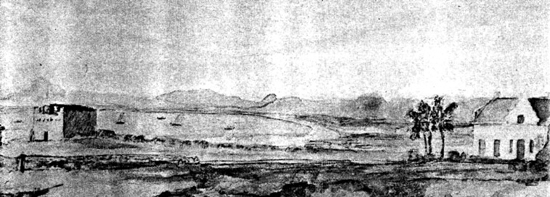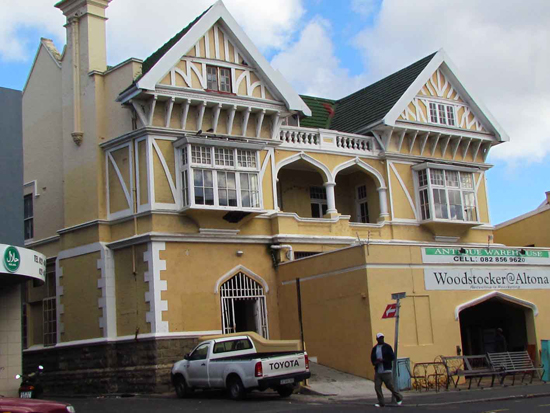13 Bakkie loads. A few hundred human hours. Just over a R1 000. Blood, sweat, tears, dust and dead rats. That’s what it took to turn a sick Woodstock service lane into a healthy communal space. Sybrandus Adema got all the dirt.
It all started innocently enough… Having just moved into Woodstock, we were strolling around the hood when we noticed something. Whereas some service lanes, such as Woodworm and Wadham, where attractive havens of peace, the one behind our house, between Chamberlain and Balfour Streets, looked as if it had been hit by various aerial bombing raids since 1971. Or a tropical cyclone dressed up as a Southeaster last summer.
One thing led to another, and before I knew it, a terrible affliction dug its claws into me – a monster called Lane Envy. My soul was tormented by thoughts: These lanes are the blood vessels pumping through the neighbourhood. They carry fresh water supplies, storm water, telephone lines; they serve as emergency exits in case of fire and crime. They are alternative entrances to properties – for emergency personnel, for gardening, moving and building purposes. And most are gated at both sides, so they are safe places for children to play in, learn how to ride a bicycle, grow some vegetables in pots, take the cats for a walk…
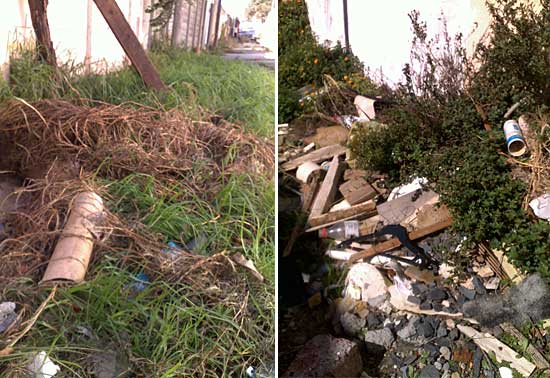
Why was ours a clogged artery, full of rubble, weeds, dog excrement, dead rats, broken lights? Hounslow Lane/Steeg (the road sign is covered by a Frangipani) was surely a heart attack ticking away behind the back wall, a tunnel filled with mounds of shrapnel where the homeless and the criminal can hide… and where many feel comfortable enough to turn it into an even bigger rubbish dump. This even though some neighbours cleared the Lane a few years ago, marked all the properties with numbers and left numerous signs imploring “Keep our Lane Glam” and “No dumping, please”.

As swearwords in four languages couldn’t describe the trauma, only one thing remained – actually doing something about it. Following one creation of an email address and one flyer (outlining the problems, the hopes, the photos of the crime scene) distributed to all 63 adjoining properties, the support for the Lane cleanup started emailing in. Not many, but enough to get the cleansing ball rolling.
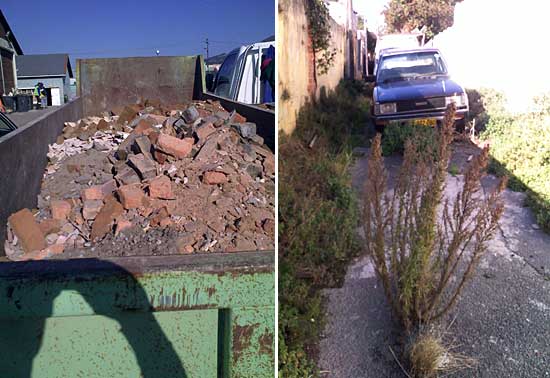
The first goal was to get rid of a lonely ‘car wreck’, abandoned for years in the middle of the Lane. A few people phoning the traffic police until they couldn’t take it anymore did the trick. Owner of said vehicle pleaded with the officers not to tow it away – and they forced him to park it in Chamberlain Street, better known for its trees than ample parking space. Ag, small victories are better than none.
The weather forecast looked good, the timing was right, the email went out, and another flyer was launched: coming Saturday would be L Day. Alas, most of the cyber participants were out of town (or something) but many donated or promised money. Some came whispering “It’s not my rubble there” or “It was the owner before me” or “I’m sure it’s neighbour Sies that dumped those things there”. No point in crying over spilt rubbish; the important issue was, how many people would pitch up?
Saturday morning. 9AM. Caffeine kicking in. I open the door slowly. I peer down the Lane.
And what a sight it was. First one person, then two, some more peeking out of their gates, and soon the sound of 12 scraping shovels resonated throughout the Lane. The doctor, the paint seller, the chef, the journalist, the carpenter, the filmmaker – all targeting their pet-hate rubble pile. Transport was a problem, but later two bakkies attacked the mounds of rubble from both sides. We met the neighbours, got sweaty and exchanged pleasantries. Within hours the place looked like disaster emergency workers and an NGO had arrived to save the day – the only thing missing was CNN. Down at the Woodstock dump, the trouble was separating some of the rubbish – wood, plastic garden, ‘clean’ building rubble, mice – but the people working there are cool, and masters of recycling (if you need compost, swing by).
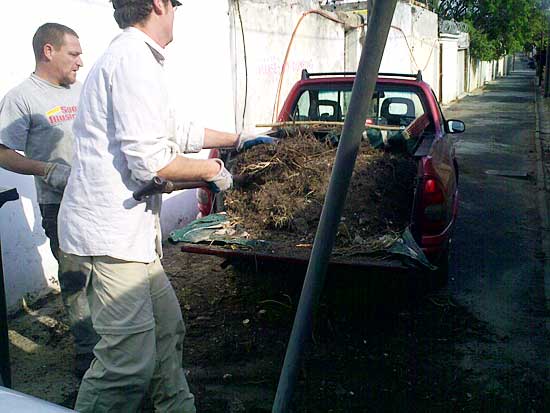
To get rid of the last mounds took another 2 days, and many more bakkie loads. The participants dried up, more money poured in and extra help was bought as a few die-hards attacked the last gemors. No Parking and No Dumping signs went up on the gates. And then a well-paid immigrant attacked it with a broom, to place his stamp of approval on the sweeping change…
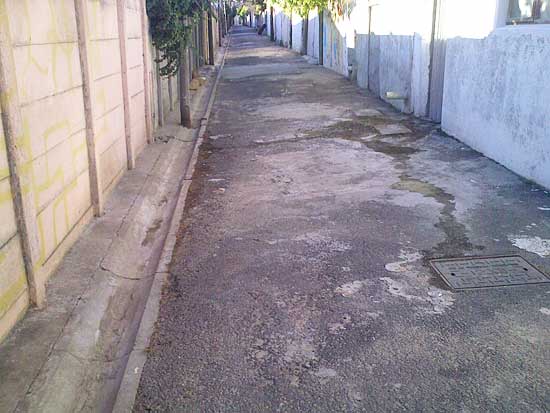
To celebrate, a ‘Reclaim the Lane’ party took place – the most popular and well attended of all the gatherings. This time armed with chairs, tables, braai equipment, food, drinks and more plans to make this communal space (all 850m of it) more convivial, neighbours converged on the centre throughout the day. People opened their Lane-facing garages, put on music and got the fires going. Kids played, dogs barked, cats came to investigate. One group of neighbours looked over their wall, wondering if they could jump over or needed to walk all around. No, no, no, we said, and within seconds the prefab cements slabs were lifted off to create an entrance to their new ‘streetscape’. What was supposed to be a brunch went on until dark – with much fun, laughter, and handshaking, not to mention stories regarding the Lane’s history, the vrot to hot transformation and a particular offender who constantly misplaces the gate keys.
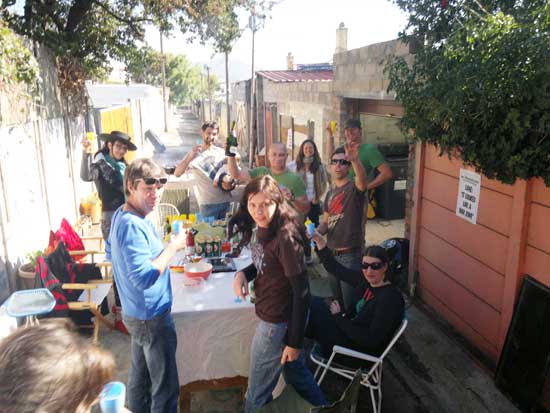
A spring jol is next in the pipe-lane, so the question is, who has Lane Envy now, mmmmmm? Maybe the people around Rainham Lane (this is not a subtle hint!)…
PS: Once a service lane is gated, the city council will not clear the rubble, but will still look after the infrastructure (lights, water pipes etc). Many Woodstockers have decided the best way to (not) deal with lane issues, is to go into denial by closing up their back walls and decorating it with barbed wire, broken glass and electric fencing.
Here’s the challenge: Turn your trashy service lane or alley into a beautiful haven and send in your stories and photos to . If your lane is not gated, to have it cleaned you can call Cape Town City’s Solid Waste department on 0860 103 089 or email [email protected] (and report illegal dumping to them as well). The Roads and Stormwater department (broken roads/lane surfaces) can be contacted via 0860 103 054 or [email protected] and Water & Sanitation department (leaks, sewerage) on 0860 103 089 or [email protected]. We can’t wait to see the Before and After pics!













































